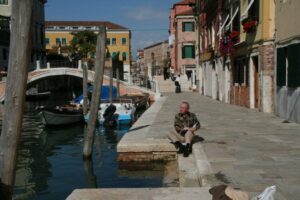
Take Monet’s large water lily murals for example. There are photos showing these paintings being executed in his studio at Giverny. There are also photos in existence which he took of the water lily pond, and since the pond isn’t visible from the studio it’s likely that he used them as reference for the murals.
The American Impressionist, Theodore Robinson, left photos with grid marks on them which are used in transferring more accurately the photo to the canvas, and also left paintings which are almost exact replicas of the photos.
And in some of Corot’s later work figures appear which could only have been arrived at through the use of photographic reference. For instance, there is a horse and rider which appears in more than one of his later paintings. It is a small figure, but it is photographically accurate, even though the horse is in motion and could only have been in that pose for a fraction of a second. And we know both from his sketches and from his own admission that he could not capture such details in so limited a time working from the subject.
So, well-known artists have worked from different types of sources, but which is best?
Working directly from the subject out-of-doors is called “plein air”. It is good practice, especially for beginners, because it forces you to work rapidly under less than favorable conditions, and this brings your instincts into play and causes you to learn more rapidly and to paint more spontaneously. It has the disadvantage of lighting which is always changing, bugs in your paint and comments from curious passersby. Most artists who paint this way solve the first problem by taking a photo early on which they later use in the studio to make corrections and apply finishing touches.
If you do want to use photos, here are some pointers: Use only your own photos. Photography is an art form and the photos you take represent your personal knowledge concerning what makes a good picture. Never use published professional photos. These were not your ideas, and in some places there are laws against their use. Don’t slavishly copy the photo. All good artists develop their own ideas about color, composition, etc., which they impose on the subject.
Carol Lundeen says
Thank you, Mr. Cox, for acknowledging the use of photos as a good tool for references. I get weary of people who put others down and try to diminish their wonderful works of art because they use photographs as a resource. If an artist decides to use photographs and studies his/her camera so they can take proper photos with all the right lighting, there is no reason why a photo “shouldn’t” be used to paint by. A good artist knows not to be a slave to the photo. And a good artist knows how to see into the shadows. I am willing to bet that there are a lot of big name artists who paint from photos and just aren’t saying so. When they go out on their painting trips, I find it really hard to believe that all they take back home with them are the plein air paintings. Plein Air artists are wonderful people. But can we all please stop bickering over this issue, get off our high horses and truly accept and appreciate the talents and efforts we all put forth?
Sue Gilkey says
I thank you too. This is a great discussion. We should limit ourselves to judging the paintings, not the process. Photographs are really just another tool in the
Complicated box that artists use to create the final work. As an artist, I’m not a fan of rules, so why as a group do we want to make rules for artist’s to work by?
T Tilton says
Several
points and quibbles: There is no indication that Monet worked from photographs.
More likely he worked as many artists worked, from their plein aire sketches
and paintings and from their memories. Corot is known for working from photographs.
Either way, the reason I tell my students to paint and draw from life is
because it is a fundamental skill—i.e. turning something three-dimensional into
something two-dimensional. I find many students who do work solely from photos can not paint from life. Painting from life teaches them to see color and dimension, which is terribly
limited in photography; to seeing the color of light and the color of shadows—for starters. Hopefully,
when they do use photography in the studio—a useful tool—they stop laboriously
copying the photo and paint what they want to say, not just what they saw.
Jim Connelly says
I could not agree more. I would put the heaviest emphasis on painting from life but all are great ways to learn and paint.
JoAnn Swearingen says
I agree that plein aire is necessary and ranks over even painting inside a sun room or conservatory. I like to paint outdoors because I can “connect” with the environment–see the nuances of color, texture, value and feel the “rhythm” of nature changing, growing, developing. In the studio, photos help me to edit or capture details I may have forgotten but, more importantly, to relive the experience.